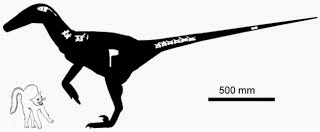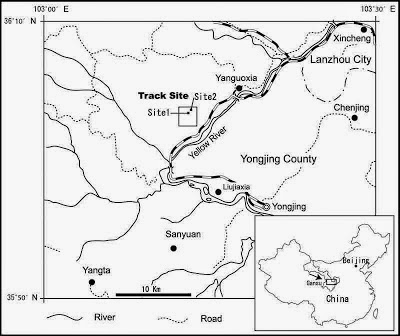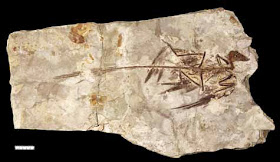In December 2000 Xing Xu, Zonghe Zhou and Xioalin Wang of the Institute of Vertebrate Paleontologyand Paleoanthropology of the Chinese Academy of Sciences described a new species
of Dromaeosaurid from the Early Cretaceous Jiufotang Formation of western
Liaoning Province in a paper in the journal Nature. This was the smallest
non-Avian Dinosaur ever found, and showed a remarkable similarity to the
earliest Birds, including an extensive covering of feathers.
This Dinosaur was named Microraptor zhaoianus,
and since this time a number of further specimens of Microraptor have been discovered and two further species have been
described (though these are not universally accepted). Remarkably the new
specimens have revealed further Bird-like features, including the presence of
two pairs of wings (unlike in Birds, the hindlimbs of Microraptor were also modified for flight).
In a paper published in the American Museum Novitates on 22 December
2014, Rui Pei of the Division of Paleontology at the American Museum of NaturalHistory, Quangou Li of the State Key Laboratory of Biogeology and Environmental
Geology at the China University of Geosciences, Qingjing Meng of the BeijingMuseum of Natural History, Ke-Qin Gao of the School of Earth and Space Sciences
at Peking University and Mark Norell, also of the Division of Paleontology at
the American Museum of Natural History, describe a new specimen of Microraptor zhaoianus from the same
deposits as the original (and all subsequent) specimens.
The new specimen of Microraptor zhaoianus, view of entire mounted slab. Pei et al. (2014).
The new specimen is exceptionally well preserved, possessing a
number of features not seen in other specimens. It shows several traits
previously described that clearly mark Microraptor
out as a Dromaeosaur, including extremely elongate prezygapophyses and chevrons
(re-enforcing structures that help support the rigid tail in Dinosaurs –
check), a vertical process on the posteromedial corner of the retroarticular
process of the mandible and a reduced manual phalanx III-2, and in addition
another Dromaeosaur trait not seen in any previously described specimen, dorsal
displacement of the maxillary fenestra and a large quadrate foramen.
Skull and mandible of the new specimen of Microraptor zhaoianus, photograph (top)
and interpretive drawing (bottom). Abbreviations: aof, antorbitalfenestra; emf,
external mandibularfenestra; hy, hyoid; j, jugal; l, lacrimal; lan, left
angular; lar, left articular; ld, left dentary; lfr, left frontal; lsp, left
splenial; m, maxilla; mf, maxillary fenestra; n, nasal; na, naris; pa, parietal;
pm, premaxilla; po, postorbital; pra, prearticular; q, quadrate; qj, quadratojugal;
ran, right angular; rar, right articular; rfr, right frontal; sa, surangular;
sq, squamosal. Pei et al. (2014).
The new specimen also shows a number of features in common with
early Troodontids which have been reported in other specimens, such as a short subnarial
process on the premaxilla, smaller teeth on the premaxilla than on the maxilla,
no denticles on the anterior carinae of the maxillary teeth and a
Troodontid-like articulation of the foot. In addition this specimen has a
better-preserved maxilla and face than previous specimens, showing other
Troodontid-like features, such as a shallow main body of the bone and a slender
interfenestral bar combined with an enlarged maxillary fenestra. This supports
the close relationship of the Dromaeosaurs and Troodontids previously proposed;
the two are currently grouped together to form the Deinonychosauria, to the
exclusion of other Maniraptors, including the Birds.
However the arrangement of the rib-cage in the new specimen is
probably its most remarkable feature, this preserves gastralia and uncinate
processes, features known from a variety of Theropod Dinosaurs including other
Dromeaosaurs, but in this case remarkably similar to those of the early Bird Confuciusornis. This suggests that
respiration in Microraptorwas similar
to that in early Birds, lending further weight to the idea that it could also
fly.
The rib cage of the new specimen of Microraptor zhaoianus. Abbreviations: dr,
dorsal rib; h, humerus; lms, left medial segment of gastralia; rls, right
lateral segment of gastralia; rms, right medial segment of gastralia; sc, scapular;
st, sternum; up, uncinate process. Pei et
al. (2014).
See also…
 New species of Dromaeosaur from the Early Cretaceous of Utah. Dromaeosaurs were small Therapod Dinosaurs, thought to have been the
group most closely related to...
New species of Dromaeosaur from the Early Cretaceous of Utah. Dromaeosaurs were small Therapod Dinosaurs, thought to have been the
group most closely related to... Dinosaur footprints from the Early Cretaceous of Ganzu Province, China. The Deinonychosaurs are the group of dinosaurs most closely related to
the birds. They are divided into two groups, the Dromaeosaurs (popularly
known as 'Raptors') and the Troodontids, which share a common hindlimb
morphology, with two digits used to support...
Dinosaur footprints from the Early Cretaceous of Ganzu Province, China. The Deinonychosaurs are the group of dinosaurs most closely related to
the birds. They are divided into two groups, the Dromaeosaurs (popularly
known as 'Raptors') and the Troodontids, which share a common hindlimb
morphology, with two digits used to support... How did raptors use their claws? (and did it help them learn to fly?) The Dromaeosaurs were a group of small, feathered dinosaurs closely
related to the birds. They are commonly referred to as 'raptors' on
account of an enlarged claw on each foot which was held clear of the
ground when walking and is generally assumed to have been a weapon; this
claw resembles that of a bird of prey, which are also referred to as
'raptors'. This claw was also present in the other group...
How did raptors use their claws? (and did it help them learn to fly?) The Dromaeosaurs were a group of small, feathered dinosaurs closely
related to the birds. They are commonly referred to as 'raptors' on
account of an enlarged claw on each foot which was held clear of the
ground when walking and is generally assumed to have been a weapon; this
claw resembles that of a bird of prey, which are also referred to as
'raptors'. This claw was also present in the other group...
Follow Sciency Thoughts on Facebook.




